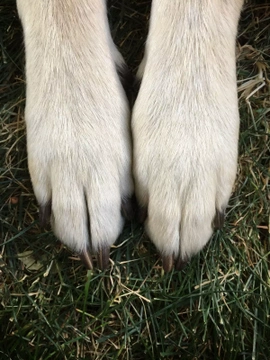
My dog has broken its nail. What should I do?
Dogs may sometimes break a nail when they are out and about on a walk. The dew claw, above the paw, is more loosely attached and is therefore most prone to damage. Although some dogs have naturally stronger nails than others, it is important to keep your dog’s nails short to reduce the risk of them getting caught or cracking. Nail clipping should be done carefully and regularly. This article covers what to look for and what to do if your dog breaks a nail.
Causes of a broken nail
Long nails are more likely to chip, tear, split or break, which can be painful to your dog and may require veterinary treatment. When a dog stands or walks on a long nailed paw it puts pressure on the wrong parts of the foot, causing pain and discomfort and can ultimately contribute to joint issues especially in older dogs.
Clinical signs a broken or fractured nail
- Limping: this may be mild, moderate or severe depending on where and how the nail has broken. Your dog may also be reluctant to weight-bear on the affected leg.
- Bleeding: the broken nail may bleed if the nail bed is damaged.
- Licking: your dog may lick the affected claw repeatedly.
How can you help your dog?
- Get your dog used to having their feet touched at an early age. Start by rubbing their feet and putting a small amount of pressure on their toes. Let your dog investigate the nail clippers, and, once relaxed, clip a tiny tip off one nail whilst providing positive reinforcement. Do this regularly so that it doesn’t become a problem or something to be scared of.
- Check your dog’s nails regularly. The dew claw does not come into contact with the ground and therefore can start to curl round. If not trimmed, they can grow into the pads, which becomes painful and risks infection.
- Keep your dog’s nails short. We recommend trimming them monthly. This will help to keep the sensitive kwik short and reduces the risk of accidentally cutting it when trimming.
- Exercising dogs on a hard surface, like a pavement or patio can also help to keep their nails short.
- Ask your vet or vet nurse for help with clipping your dog’s nails if needed.
- If your dog will not allow you to clip their nails, start right back at the beginning. This will involve careful training and desensitisation, as described in point 1. You will need to spend several weeks just touching your dogs nails before moving onto squeezing their toes. Finally, once they accept that, you can clip a very small tip of one of their nails. Dogs need to be rewarded and praised so that they associate this as a good experience.
Treatment of a broken or fractured nail
The most important thing to do straight away is to stop your dog from licking its foot or nail. Dogs and cats have bacteria in their mouth, which can cause an infection if they lick a broken nail. Bathe the paw twice a day with warm salt water (1 tsp salt in 500ml/1 pint cooled boiled water), or a dilute Chlorhexidine solution (1 part Hibiscrub to 20 parts water). Ensure that the paw is dried thoroughly afterwards.
To prevent them licking the paw, we recommend using a plastic Buster collar, or an inflatable Buster collar, to stop them reaching the nail. Or, try a children's sock; check that the sock isn’t too tight and stays dry at all times. The sock will need to be changed and washed daily. Any of these prevention methods should be used for at least 3-5 days, to allow the damaged tissue to seal and the signs to fully resolve. Grannicks Bitter Apple spray (available online and from pet shops or your vet) can be applied to the sock to stop your dog from chewing it. However, do not apply it directly to a wound.
Avoid woodland walks or muddy areas until the damaged nail has dried up. If necessary, limit walks to short lead-walks, for toileting only, until the nail has fully healed. In this way the nail will heal faster and your dog will be back to normal much more quickly. You can use a dog boot, such as a Mikki boot or a Therapaws boot, to protect the area whilst walking. After walks, ensure that the affected paw is cleaned and dried.
When to see your physical vet
- If your dog’s nail is broken but still attached or is at an awkward angle. At the vet clinic they will be able to clip your dog’s nail. If it is too painful to touch, they can discuss sedation and removal of the damaged nail, if required.
- If the base of the nail is red, there is swelling around the nail, discharge, or your dog is lame.



